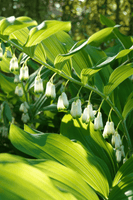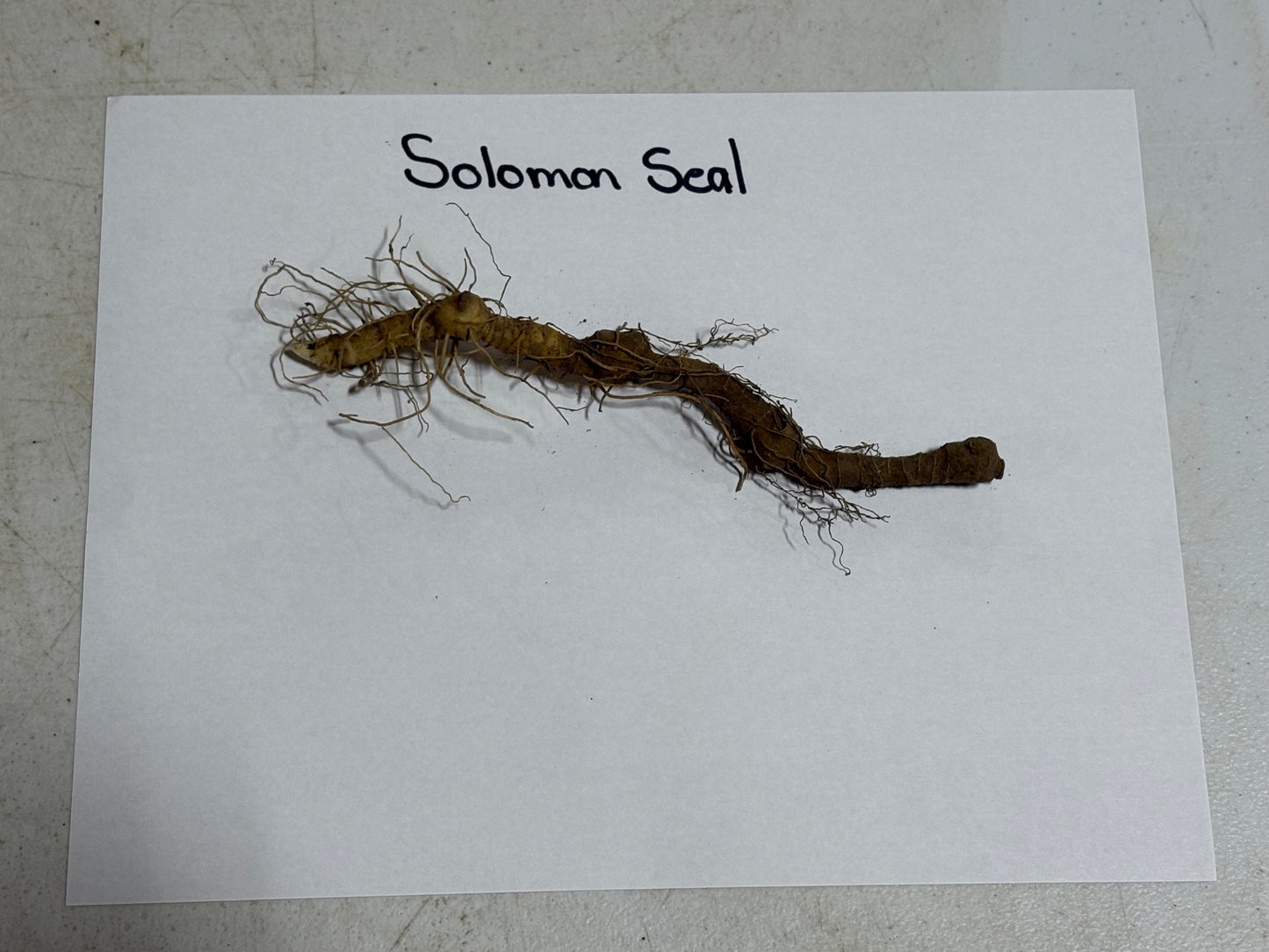




Couldn't load pickup availability
🌸When you add 1 plant to cart, it automatically adds the free one
Solomon’s Seal Plants for Sale -Polygonatum Biflorum
Solomon’s Seal is a much-loved native perennial plant with bell-shaped white flowers that hang from the long, arching stems. Leaves are beautifully and lightly variegated with white streaks that look as though Mother Nature painted on them. It's hardy and has a long lifespan, returns every Spring season, and reblooms annually.
Another loved aspect of this perennial is its white flowers complement paired leaves. After flowering, dark blue berries will develop making it a highly prized perennial for flower beds.
Solomon's Seal Plants Details
Family: Asparagaceae
Light Requirement: Shade
Water Needs: Moderate
Height: 2 – 3 ft.
Spread: 1 – 2 ft.
Growth Rate: Slow
Bloom Time: Spring
Flower Color: White
Wildlife Value: Attracts bees and butterflies.
Landscape Uses and Maintenance of Solomon’s Seal Plant
Add this plant to your shady border or woodland garden. When it dies back, it will leave gaps, so be sure to plant other perennials to fill in the spots it leaves behind. It pairs beautifully with other spring-blooming perennials like Astilbe and Bleeding Heart and with spreading ferns.
As an understory plant, it will thrive in an area with full to partial shade that is out of afternoon sun. The afternoon sun will lead to sun scald.
This is a low maintenance plant that will need watering infrequently, making it a great choice for the busy gardener. However, make sure to water thoroughly and frequently from when you receive your plant until the root system is well established.
This plant prefers rich soil with plenty of organic matter. Add compost, leaf mold, or similar to the soil around this plant to give it rich soil. Fertilize in the early spring time before the new growth begins to encourage vigorous flowers to develop.
It will slowly naturalize and spread in your garden, given enough space to do so and proper growing conditions, via its expanse of underground rhizomes. You can make the process faster by digging up parts of your plants to divide and replant.
Deer resistant. Watch this plant for nematode, slug, and snail activity. You will know they have found your plants when you see small holes or brown streaks on the leaves.
Noteworthy Characteristics of Solomon’s Seal Plant
Solomon’s Seal attracts birds and butterflies.
This Is How Your Plants Will Look upon Delivery

Bloom Season
Spring
Bloom/Foliage Color
White
Height at Maturity
Over 12"
Care
Solomon's Seal thrives in well-drained soil with consistent moisture. Mulch near the plant to maintain moisture and suppress weeds. Prune dead or damaged stems in early spring to encourage new growth. Watch for nuisances like spider mites and treat them as needed.
Plant Reproduction
Solomon's Seal Plant spreads slowly by creeping underground stems called rhizomes.
How to Grow and Care for Bare Root Perennials, Tubers, and Bulbs
Bare root perennials, tubers, and bulbs are an easy and economical way to jumpstart your garden with lasting beauty. These dormant plants should be planted in early spring or fall while the soil is cool and workable. Before planting, soak bare roots in water for 1–2 hours to rehydrate them. Choose a location based on the plant’s light needs—most flowering types prefer full sun, while others thrive in partial shade.
For bare root perennials, dig a shallow hole and spread the roots out naturally, ensuring the crown is level with the soil surface. For tubers and bulbs, plant with the pointed side facing up at a depth about two to three times their height. Cover with soil, gently press down, and water thoroughly.
Keep soil consistently moist (not soggy) until new growth appears. Add mulch to retain moisture and suppress weeds, but avoid covering the crown or bulb tops. Once established, these plants require little maintenance—just seasonal watering, occasional dividing, and deadheading or pruning as needed. With proper care, they’ll return and thrive year after year.
Shipping date depends on the date displayed and chosen when you order from the product's page.
We only accept returns on plants verified dead. If you think your plants have died, we offer a 1 year warranty, please use use this File a Claim Link to verify dead plants and start with return warranty process.




Caring Tips
How do I care for my Solomon's Seal Plant?
Each box contains detailed care instructions and information about your product. But here's the basics.
Care Tips
Solomon's Seal thrives in well-drained soil with consistent moisture. Mulch near the plant to maintain moisture and suppress weeds. Prune dead or damaged stems in early spring to encourage new growth. Watch for nuisances like spider mites and treat them as needed.
Light Requirements
Solomon's Seal prospers in partial to complete shade. It prefers dappled sunlight or light, filtered shade, making it ideal for woodland gardens or shaded areas. Too much unaffected sun can burn its leaves.
Hardy Planting Zones
3 • 4 • 5 • 6 • 7 • 8 • 9
Delivery was flawless, and just a few tendings—mulch and shade—it settled fast. Now it’s echoing forest charm quietly.
Imported into my moist, humus-rich bed, its white bells appeared within weeks. Deer ignore it, pollinators love it—perfect woodland touch.
This Solomon’s Seal has dreamy arching stems and lush leaves—planted in dappled shade, it’s elegant year-round and blooms gracefully.
The plant is healthy and clean, though it hasn’t flowered yet. Given enough shade and compost, I imagine mid-summer bells will show.
Nice arching leaves with a hint of bloom buds beneath. Set under trees, now adding compost to enrich the soil.
